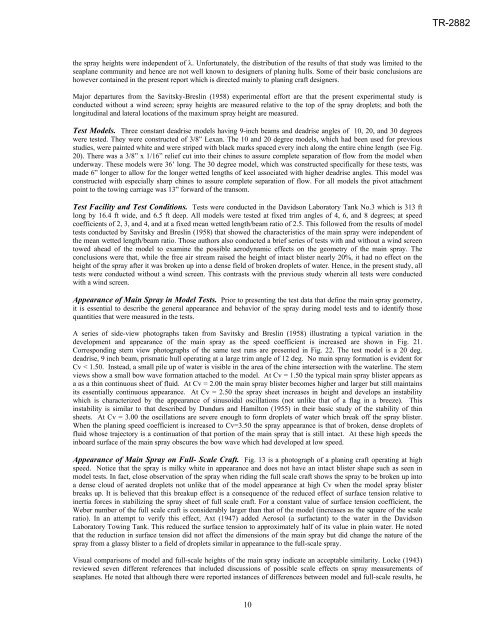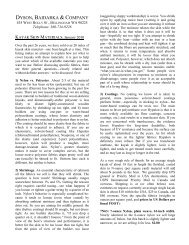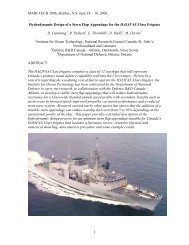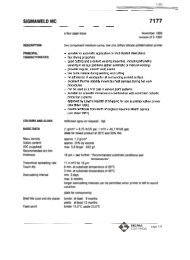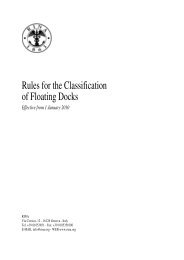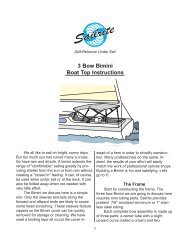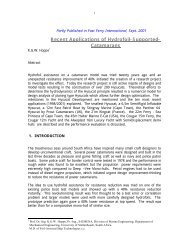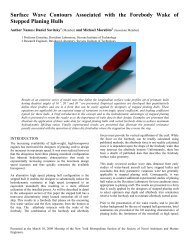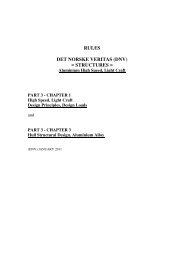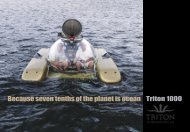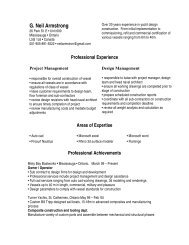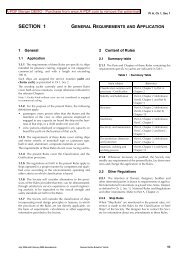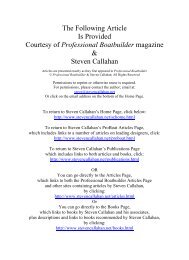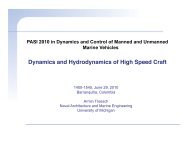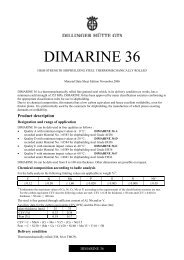Origin and Characteristics of the Spray Patterns TR-2882 3-10 ...
Origin and Characteristics of the Spray Patterns TR-2882 3-10 ...
Origin and Characteristics of the Spray Patterns TR-2882 3-10 ...
You also want an ePaper? Increase the reach of your titles
YUMPU automatically turns print PDFs into web optimized ePapers that Google loves.
<strong>TR</strong>-<strong>2882</strong><br />
<strong>the</strong> spray heights were independent <strong>of</strong> λ. Unfortunately, <strong>the</strong> distribution <strong>of</strong> <strong>the</strong> results <strong>of</strong> that study was limited to <strong>the</strong><br />
seaplane community <strong>and</strong> hence are not well known to designers <strong>of</strong> planing hulls. Some <strong>of</strong> <strong>the</strong>ir basic conclusions are<br />
however contained in <strong>the</strong> present report which is directed mainly to planing craft designers.<br />
Major departures from <strong>the</strong> Savitsky-Breslin (1958) experimental effort are that <strong>the</strong> present experimental study is<br />
conducted without a wind screen; spray heights are measured relative to <strong>the</strong> top <strong>of</strong> <strong>the</strong> spray droplets; <strong>and</strong> both <strong>the</strong><br />
longitudinal <strong>and</strong> lateral locations <strong>of</strong> <strong>the</strong> maximum spray height are measured.<br />
Test Models. Three constant deadrise models having 9-inch beams <strong>and</strong> deadrise angles <strong>of</strong> <strong>10</strong>, 20, <strong>and</strong> 30 degrees<br />
were tested. They were constructed <strong>of</strong> 3/8” Lexan. The <strong>10</strong> <strong>and</strong> 20 degree models, which had been used for previous<br />
studies, were painted white <strong>and</strong> were striped with black marks spaced every inch along <strong>the</strong> entire chine length (see Fig.<br />
20). There was a 3/8” x 1/16” relief cut into <strong>the</strong>ir chines to assure complete separation <strong>of</strong> flow from <strong>the</strong> model when<br />
underway. These models were 36’ long. The 30 degree model, which was constructed specifically for <strong>the</strong>se tests, was<br />
made 6” longer to allow for <strong>the</strong> longer wetted lengths <strong>of</strong> keel associated with higher deadrise angles. This model was<br />
constructed with especially sharp chines to assure complete separation <strong>of</strong> flow. For all models <strong>the</strong> pivot attachment<br />
point to <strong>the</strong> towing carriage was 13” forward <strong>of</strong> <strong>the</strong> transom.<br />
Test Facility <strong>and</strong> Test Conditions. Tests were conducted in <strong>the</strong> Davidson Laboratory Tank No.3 which is 313 ft<br />
long by 16.4 ft wide, <strong>and</strong> 6.5 ft deep. All models were tested at fixed trim angles <strong>of</strong> 4, 6, <strong>and</strong> 8 degrees; at speed<br />
coefficients <strong>of</strong> 2, 3, <strong>and</strong> 4, <strong>and</strong> at a fixed mean wetted length/beam ratio <strong>of</strong> 2.5. This followed from <strong>the</strong> results <strong>of</strong> model<br />
tests conducted by Savitsky <strong>and</strong> Breslin (1958) that showed <strong>the</strong> characteristics <strong>of</strong> <strong>the</strong> main spray were independent <strong>of</strong><br />
<strong>the</strong> mean wetted length/beam ratio. Those authors also conducted a brief series <strong>of</strong> tests with <strong>and</strong> without a wind screen<br />
towed ahead <strong>of</strong> <strong>the</strong> model to examine <strong>the</strong> possible aerodynamic effects on <strong>the</strong> geometry <strong>of</strong> <strong>the</strong> main spray. The<br />
conclusions were that, while <strong>the</strong> free air stream raised <strong>the</strong> height <strong>of</strong> intact blister nearly 20%, it had no effect on <strong>the</strong><br />
height <strong>of</strong> <strong>the</strong> spray after it was broken up into a dense field <strong>of</strong> broken droplets <strong>of</strong> water. Hence, in <strong>the</strong> present study, all<br />
tests were conducted without a wind screen. This contrasts with <strong>the</strong> previous study wherein all tests were conducted<br />
with a wind screen.<br />
Appearance <strong>of</strong> Main <strong>Spray</strong> in Model Tests. Prior to presenting <strong>the</strong> test data that define <strong>the</strong> main spray geometry,<br />
it is essential to describe <strong>the</strong> general appearance <strong>and</strong> behavior <strong>of</strong> <strong>the</strong> spray during model tests <strong>and</strong> to identify those<br />
quantities that were measured in <strong>the</strong> tests.<br />
A series <strong>of</strong> side-view photographs taken from Savitsky <strong>and</strong> Breslin (1958) illustrating a typical variation in <strong>the</strong><br />
development <strong>and</strong> appearance <strong>of</strong> <strong>the</strong> main spray as <strong>the</strong> speed coefficient is increased are shown in Fig. 21.<br />
Corresponding stern view photographs <strong>of</strong> <strong>the</strong> same test runs are presented in Fig. 22. The test model is a 20 deg.<br />
deadrise, 9 inch beam, prismatic hull operating at a large trim angle <strong>of</strong> 12 deg. No main spray formation is evident for<br />
Cv < 1.50. Instead, a small pile up <strong>of</strong> water is visible in <strong>the</strong> area <strong>of</strong> <strong>the</strong> chine intersection with <strong>the</strong> waterline. The stern<br />
views show a small bow wave formation attached to <strong>the</strong> model. At Cv = 1.50 <strong>the</strong> typical main spray blister appears as<br />
a as a thin continuous sheet <strong>of</strong> fluid. At Cv = 2.00 <strong>the</strong> main spray blister becomes higher <strong>and</strong> larger but still maintains<br />
its essentially continuous appearance. At Cv = 2.50 <strong>the</strong> spray sheet increases in height <strong>and</strong> develops an instability<br />
which is characterized by <strong>the</strong> appearance <strong>of</strong> sinusoidal oscillations (not unlike that <strong>of</strong> a flag in a breeze). This<br />
instability is similar to that described by Dundurs <strong>and</strong> Hamilton (1955) in <strong>the</strong>ir basic study <strong>of</strong> <strong>the</strong> stability <strong>of</strong> thin<br />
sheets. At Cv = 3.00 <strong>the</strong> oscillations are severe enough to form droplets <strong>of</strong> water which break <strong>of</strong>f <strong>the</strong> spray blister.<br />
When <strong>the</strong> planing speed coefficient is increased to Cv=3.50 <strong>the</strong> spray appearance is that <strong>of</strong> broken, dense droplets <strong>of</strong><br />
fluid whose trajectory is a continuation <strong>of</strong> that portion <strong>of</strong> <strong>the</strong> main spray that is still intact. At <strong>the</strong>se high speeds <strong>the</strong><br />
inboard surface <strong>of</strong> <strong>the</strong> main spray obscures <strong>the</strong> bow wave which had developed at low speed.<br />
Appearance <strong>of</strong> Main <strong>Spray</strong> on Full- Scale Craft. Fig. 13 is a photograph <strong>of</strong> a planing craft operating at high<br />
speed. Notice that <strong>the</strong> spray is milky white in appearance <strong>and</strong> does not have an intact blister shape such as seen in<br />
model tests. In fact, close observation <strong>of</strong> <strong>the</strong> spray when riding <strong>the</strong> full scale craft shows <strong>the</strong> spray to be broken up into<br />
a dense cloud <strong>of</strong> aerated droplets not unlike that <strong>of</strong> <strong>the</strong> model appearance at high Cv when <strong>the</strong> model spray blister<br />
breaks up. It is believed that this breakup effect is a consequence <strong>of</strong> <strong>the</strong> reduced effect <strong>of</strong> surface tension relative to<br />
inertia forces in stabilizing <strong>the</strong> spray sheet <strong>of</strong> full scale craft. For a constant value <strong>of</strong> surface tension coefficient, <strong>the</strong><br />
Weber number <strong>of</strong> <strong>the</strong> full scale craft is considerably larger than that <strong>of</strong> <strong>the</strong> model (increases as <strong>the</strong> square <strong>of</strong> <strong>the</strong> scale<br />
ratio). In an attempt to verify this effect, Axt (1947) added Aerosol (a surfactant) to <strong>the</strong> water in <strong>the</strong> Davidson<br />
Laboratory Towing Tank. This reduced <strong>the</strong> surface tension to approximately half <strong>of</strong> its value in plain water. He noted<br />
that <strong>the</strong> reduction in surface tension did not affect <strong>the</strong> dimensions <strong>of</strong> <strong>the</strong> main spray but did change <strong>the</strong> nature <strong>of</strong> <strong>the</strong><br />
spray from a glassy blister to a field <strong>of</strong> droplets similar in appearance to <strong>the</strong> full-scale spray.<br />
Visual comparisons <strong>of</strong> model <strong>and</strong> full-scale heights <strong>of</strong> <strong>the</strong> main spray indicate an acceptable similarity. Locke (1943)<br />
reviewed seven different references that included discussions <strong>of</strong> possible scale effects on spray measurements <strong>of</strong><br />
seaplanes. He noted that although <strong>the</strong>re were reported instances <strong>of</strong> differences between model <strong>and</strong> full-scale results, he<br />
<strong>10</strong>


